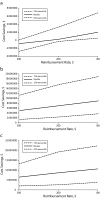Doula care, birth outcomes, and costs among Medicaid beneficiaries
- PMID: 23409910
- PMCID: PMC3617571
- DOI: 10.2105/AJPH.2012.301201
Doula care, birth outcomes, and costs among Medicaid beneficiaries
Abstract
Objectives: We compared childbirth-related outcomes for Medicaid recipients who received prenatal education and childbirth support from trained doulas with outcomes from a national sample of similar women and estimated potential cost savings.
Methods: We calculated descriptive statistics for Medicaid-funded births nationally (from the 2009 Nationwide Inpatient Sample; n = 279,008) and births supported by doula care (n = 1079) in Minneapolis, Minnesota, in 2010 to 2012; used multivariate regression to estimate impacts of doula care; and modeled potential cost savings associated with reductions in cesarean delivery for doula-supported births.
Results: The cesarean rate was 22.3% among doula-supported births and 31.5% among Medicaid beneficiaries nationally. The corresponding preterm birth rates were 6.1% and 7.3%, respectively. After control for clinical and sociodemographic factors, odds of cesarean delivery were 40.9% lower for doula-supported births (adjusted odds ratio = 0.59; P < .001). Potential cost savings to Medicaid programs associated with such cesarean rate reductions are substantial but depend on states' reimbursement rates, birth volume, and current cesarean rates.
Conclusions: State Medicaid programs should consider offering coverage for birth doulas to realize potential cost savings associated with reduced cesarean rates.
Figures

Similar articles
-
Potential benefits of increased access to doula support during childbirth.Am J Manag Care. 2014 Aug 1;20(8):e340-52. Am J Manag Care. 2014. PMID: 25295797 Free PMC article.
-
Modeling the Cost-Effectiveness of Doula Care Associated with Reductions in Preterm Birth and Cesarean Delivery.Birth. 2016 Mar;43(1):20-7. doi: 10.1111/birt.12218. Epub 2016 Jan 14. Birth. 2016. PMID: 26762249 Free PMC article.
-
Quantifying the association between doula care and maternal and neonatal outcomes.Am J Obstet Gynecol. 2025 Apr;232(4):387.e1-387.e43. doi: 10.1016/j.ajog.2024.08.029. Epub 2024 Aug 24. Am J Obstet Gynecol. 2025. PMID: 39187115
-
United States Doula Programs and Their Outcomes: A Scoping Review to Inform State-Level Policies.Womens Health Issues. 2024 Jul-Aug;34(4):350-360. doi: 10.1016/j.whi.2024.03.001. Epub 2024 May 9. Womens Health Issues. 2024. PMID: 38724343
-
Doula Care: A Review of Outcomes and Impact on Birth Experience.Obstet Gynecol Surv. 2023 Feb;78(2):124-127. doi: 10.1097/OGX.0000000000001103. Obstet Gynecol Surv. 2023. PMID: 36786720 Review.
Cited by
-
"Doulas shouldn't be considered visitors, we should be considered a part of [the] team": doula care in Georgia, USA during the COVID-19 pandemic.Sex Reprod Health Matters. 2022 Dec;30(1):2133351. doi: 10.1080/26410397.2022.2133351. Sex Reprod Health Matters. 2022. PMID: 36448944 Free PMC article.
-
Potential benefits of increased access to doula support during childbirth.Am J Manag Care. 2014 Aug 1;20(8):e340-52. Am J Manag Care. 2014. PMID: 25295797 Free PMC article.
-
The role of doulas in providing breastfeeding support during the COVID-19 pandemic.Int Breastfeed J. 2023 Apr 21;18(1):23. doi: 10.1186/s13006-023-00558-0. Int Breastfeed J. 2023. PMID: 37085895 Free PMC article.
-
New policies on skin-to-skin contact warrant an oxytocin-based perspective on perinatal health care.Front Psychol. 2024 Jul 9;15:1385320. doi: 10.3389/fpsyg.2024.1385320. eCollection 2024. Front Psychol. 2024. PMID: 39049943 Free PMC article.
-
Accompanying the Path of Maternity: The Life History of a Colombian Doula.J Perinat Educ. 2021 Jul 1;30(3):145-158. doi: 10.1891/J-PE-D-20-00038. J Perinat Educ. 2021. PMID: 35311198 Free PMC article.
References
-
- Martin JA, Hamilton BE, Sutton Pet al.Births: Final Data for 2009. Natl Vital Stat Rep. 2011;60(1):1–70 - PubMed
-
- Sakala C, Corry MP, Fund MM. Evidence-Based Maternity Care: What It Is and What It Can Achieve. New York, NY: Milbank Memorial Fund; 2008
-
- Corry M, Thompson J, Dilweg AC, Mazza F. Caesar’s Ghost: The Effect of the Rising Rate of C-Sections on Health Care Costs and Quality. Washington, DC: National Health Policy Forum; 2012
-
- Markus AR, Rosenbaum S. The role of Medicaid in promoting access to high-quality, high-value maternity care. Womens Health Issues. 2010;20(1 suppl):S67–S78 - PubMed
-
- The Healthcare Costs of Having a Baby. Santa Barbara, CA: Thomson Healthcare; 2007. Available at: http://www.kff.org/womenshealth/upload/whp061207othc.pdf. Accessed January 15, 2013
Publication types
MeSH terms
Grants and funding
LinkOut - more resources
Full Text Sources
Other Literature Sources
Medical

